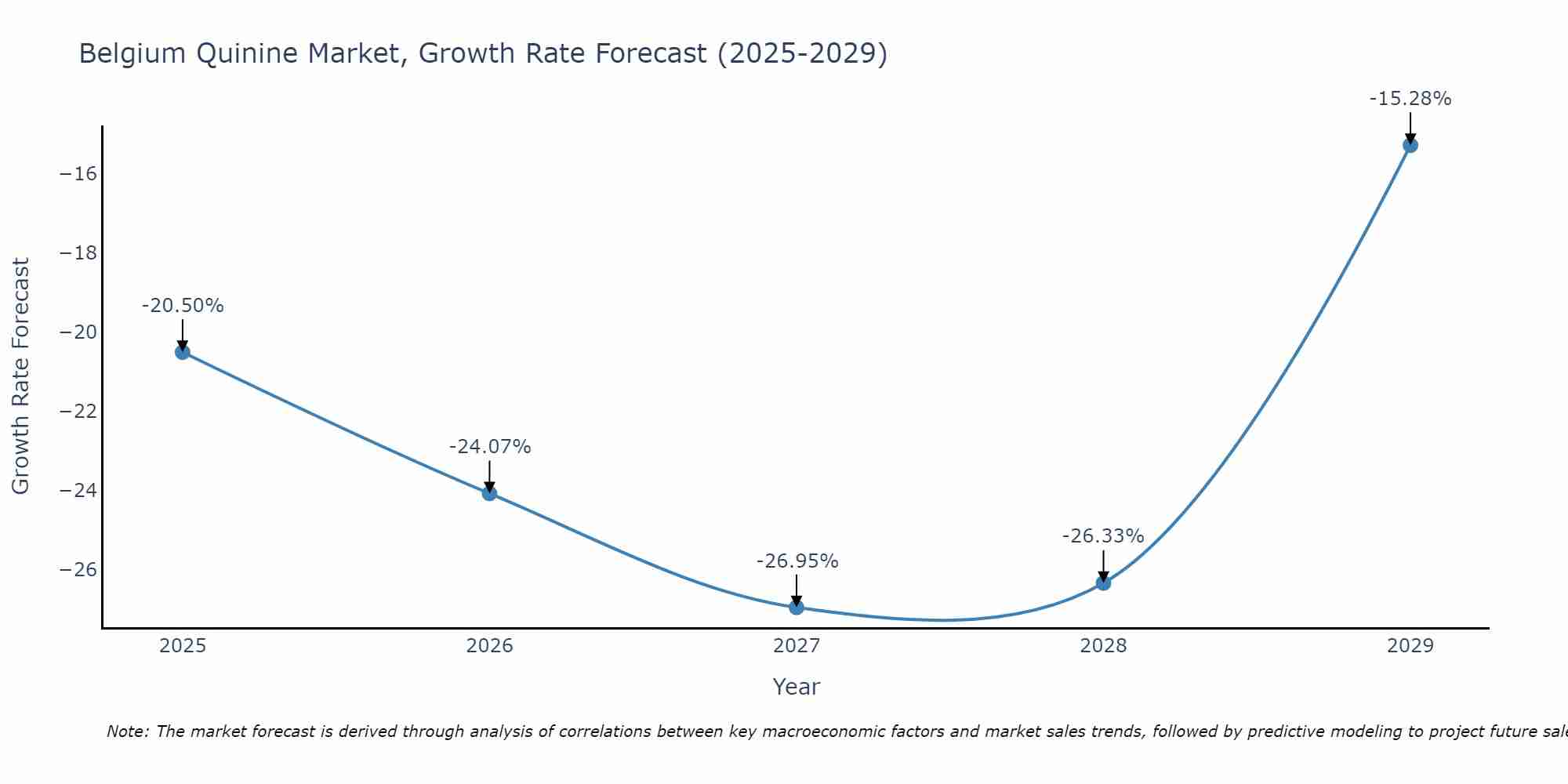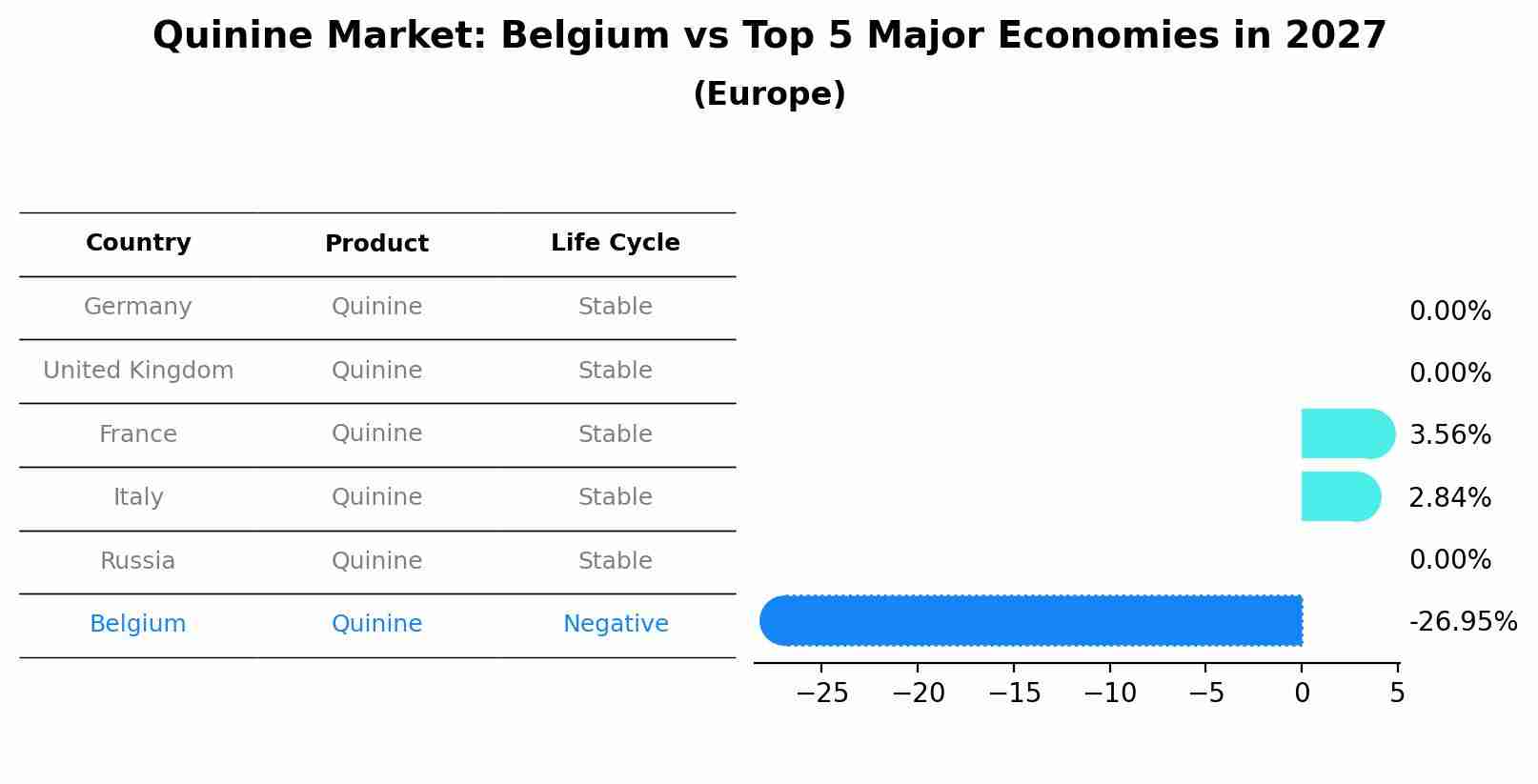Belgium Quinine Market (2025-2031) | Value, Segmentation, Companies, Forecast, Size, Outlook, Industry, Growth, Trends, Analysis, Share & Revenue
| Product Code: ETC5312422 | Publication Date: Nov 2023 | Updated Date: Aug 2025 | Product Type: Market Research Report | |
| Publisher: 6Wresearch | Author: Bhawna Singh | No. of Pages: 60 | No. of Figures: 30 | No. of Tables: 5 |
Belgium Quinine Market Size Growth Rate
The Belgium Quinine Market is projected to witness mixed growth rate patterns during 2025 to 2029. Commencing at -20.50% in 2025, growth builds up to -15.28% by 2029.

Quinine Market: Belgium vs Top 5 Major Economies in 2027 (Europe)
By 2027, the Quinine market in Belgium is anticipated to reach a growth rate of -26.95%, as part of an increasingly competitive Europe region, where Germany remains at the forefront, supported by United Kingdom, France, Italy and Russia, driving innovations and market adoption across sectors.

Belgium Quinine Market Overview
The Quinine Market in Belgium deals with the production and distribution of quinine, an alkaloid used primarily to treat malaria. It is also used in beverages like tonic water.
Drivers of the market
The quinine market in Belgium is driven by the demand for quinine as a treatment for malaria and other medical conditions. Quinine, derived from the bark of the cinchona tree, is used for its antimalarial properties and as a key ingredient in certain medications. The increasing prevalence of malaria in various regions and the need for effective treatments support the demand for quinine. Technological advancements in quinine extraction and the development of new therapeutic applications contribute to market growth. Additionally, the rising focus on healthcare and pharmaceutical research drives market dynamics.
Challenges of the market
The quinine market in Belgium encounters challenges such as managing the cost of raw materials and ensuring the quality and effectiveness of quinine products. There is also competition from alternative treatments and regulatory hurdles related to the use of quinine in pharmaceuticals. Additionally, fluctuations in global supply and demand impact the market.
Government Policy of the market
Belgiums policies on the quinine market focus on ensuring the safety and efficacy of quinine products used in medical treatments. Regulations cover aspects such as manufacturing standards, labeling, and usage guidelines to prevent misuse and ensure therapeutic effectiveness. The government also supports research into new uses and formulations of quinine to enhance its medical applications.
Key Highlights of the Report:
- Belgium Quinine Market Outlook
- Market Size of Belgium Quinine Market, 2024
- Forecast of Belgium Quinine Market, 2031
- Historical Data and Forecast of Belgium Quinine Revenues & Volume for the Period 2021-2031
- Belgium Quinine Market Trend Evolution
- Belgium Quinine Market Drivers and Challenges
- Belgium Quinine Price Trends
- Belgium Quinine Porter`s Five Forces
- Belgium Quinine Industry Life Cycle
- Historical Data and Forecast of Belgium Quinine Market Revenues & Volume By Mode of Administration for the Period 2021-2031
- Historical Data and Forecast of Belgium Quinine Market Revenues & Volume By Oral Administration for the Period 2021-2031
- Historical Data and Forecast of Belgium Quinine Market Revenues & Volume By Intravenous Administration for the Period 2021-2031
- Historical Data and Forecast of Belgium Quinine Market Revenues & Volume By Intramuscular Administration for the Period 2021-2031
- Historical Data and Forecast of Belgium Quinine Market Revenues & Volume By Others for the Period 2021-2031
- Historical Data and Forecast of Belgium Quinine Market Revenues & Volume By Application for the Period 2021-2031
- Historical Data and Forecast of Belgium Quinine Market Revenues & Volume By Antimalarial for the Period 2021-2031
- Historical Data and Forecast of Belgium Quinine Market Revenues & Volume By Antipyretic for the Period 2021-2031
- Historical Data and Forecast of Belgium Quinine Market Revenues & Volume By Others for the Period 2021-2031
- Historical Data and Forecast of Belgium Quinine Market Revenues & Volume By End-user for the Period 2021-2031
- Historical Data and Forecast of Belgium Quinine Market Revenues & Volume By Hospitals for the Period 2021-2031
- Historical Data and Forecast of Belgium Quinine Market Revenues & Volume By Clinics for the Period 2021-2031
- Historical Data and Forecast of Belgium Quinine Market Revenues & Volume By Ambulatory Surgical Centers for the Period 2021-2031
- Historical Data and Forecast of Belgium Quinine Market Revenues & Volume By Others for the Period 2021-2031
- Belgium Quinine Import Export Trade Statistics
- Market Opportunity Assessment By Mode of Administration
- Market Opportunity Assessment By Application
- Market Opportunity Assessment By End-user
- Belgium Quinine Top Companies Market Share
- Belgium Quinine Competitive Benchmarking By Technical and Operational Parameters
- Belgium Quinine Company Profiles
- Belgium Quinine Key Strategic Recommendations
Frequently Asked Questions About the Market Study (FAQs):
1 Executive Summary |
2 Introduction |
2.1 Key Highlights of the Report |
2.2 Report Description |
2.3 Market Scope & Segmentation |
2.4 Research Methodology |
2.5 Assumptions |
3 Belgium Quinine Market Overview |
3.1 Belgium Country Macro Economic Indicators |
3.2 Belgium Quinine Market Revenues & Volume, 2021 & 2031F |
3.3 Belgium Quinine Market - Industry Life Cycle |
3.4 Belgium Quinine Market - Porter's Five Forces |
3.5 Belgium Quinine Market Revenues & Volume Share, By Mode of Administration, 2021 & 2031F |
3.6 Belgium Quinine Market Revenues & Volume Share, By Application, 2021 & 2031F |
3.7 Belgium Quinine Market Revenues & Volume Share, By End-user, 2021 & 2031F |
4 Belgium Quinine Market Dynamics |
4.1 Impact Analysis |
4.2 Market Drivers |
4.2.1 Increasing awareness about the health benefits of quinine |
4.2.2 Growing demand for natural and organic ingredients in food and beverages |
4.2.3 Rising popularity of craft cocktails and mixology in Belgium |
4.3 Market Restraints |
4.3.1 Regulatory restrictions on quinine usage in certain products |
4.3.2 Competition from alternative ingredients and substitutes |
4.3.3 Fluctuations in raw material prices affecting production costs |
5 Belgium Quinine Market Trends |
6 Belgium Quinine Market Segmentations |
6.1 Belgium Quinine Market, By Mode of Administration |
6.1.1 Overview and Analysis |
6.1.2 Belgium Quinine Market Revenues & Volume, By Oral Administration, 2021-2031F |
6.1.3 Belgium Quinine Market Revenues & Volume, By Intravenous Administration, 2021-2031F |
6.1.4 Belgium Quinine Market Revenues & Volume, By Intramuscular Administration, 2021-2031F |
6.1.5 Belgium Quinine Market Revenues & Volume, By Others, 2021-2031F |
6.2 Belgium Quinine Market, By Application |
6.2.1 Overview and Analysis |
6.2.2 Belgium Quinine Market Revenues & Volume, By Antimalarial, 2021-2031F |
6.2.3 Belgium Quinine Market Revenues & Volume, By Antipyretic, 2021-2031F |
6.2.4 Belgium Quinine Market Revenues & Volume, By Others, 2021-2031F |
6.3 Belgium Quinine Market, By End-user |
6.3.1 Overview and Analysis |
6.3.2 Belgium Quinine Market Revenues & Volume, By Hospitals, 2021-2031F |
6.3.3 Belgium Quinine Market Revenues & Volume, By Clinics, 2021-2031F |
6.3.4 Belgium Quinine Market Revenues & Volume, By Ambulatory Surgical Centers, 2021-2031F |
6.3.5 Belgium Quinine Market Revenues & Volume, By Others, 2021-2031F |
7 Belgium Quinine Market Import-Export Trade Statistics |
7.1 Belgium Quinine Market Export to Major Countries |
7.2 Belgium Quinine Market Imports from Major Countries |
8 Belgium Quinine Market Key Performance Indicators |
8.1 Consumer engagement with quinine-related content on social media platforms |
8.2 Number of new product launches featuring quinine as an ingredient |
8.3 Growth in the number of bars and restaurants offering quinine-infused beverages |
8.4 Percentage increase in the use of quinine in traditional Belgian recipes |
9 Belgium Quinine Market - Opportunity Assessment |
9.1 Belgium Quinine Market Opportunity Assessment, By Mode of Administration, 2021 & 2031F |
9.2 Belgium Quinine Market Opportunity Assessment, By Application, 2021 & 2031F |
9.3 Belgium Quinine Market Opportunity Assessment, By End-user, 2021 & 2031F |
10 Belgium Quinine Market - Competitive Landscape |
10.1 Belgium Quinine Market Revenue Share, By Companies, 2024 |
10.2 Belgium Quinine Market Competitive Benchmarking, By Operating and Technical Parameters |
11 Company Profiles |
12 Recommendations | 13 Disclaimer |
- Single User License$ 1,995
- Department License$ 2,400
- Site License$ 3,120
- Global License$ 3,795
Search
Thought Leadership and Analyst Meet
Our Clients
Related Reports
- Afghanistan Apparel Market (2026-2032) | Growth, Outlook, Industry, Segmentation, Forecast, Size, Companies, Trends, Value, Share, Analysis & Revenue
- Canada Oil and Gas Market (2026-2032) | Share, Segmentation, Value, Industry, Trends, Forecast, Analysis, Size & Revenue, Growth, Competitive Landscape, Outlook, Companies
- Germany Breakfast Food Market (2026-2032) | Industry, Share, Growth, Size, Companies, Value, Analysis, Revenue, Trends, Forecast & Outlook
- Australia Briquette Market (2025-2031) | Growth, Size, Revenue, Forecast, Analysis, Trends, Value, Share, Industry & Companies
- Vietnam System Integrator Market (2025-2031) | Size, Companies, Analysis, Industry, Value, Forecast, Growth, Trends, Revenue & Share
- ASEAN and Thailand Brain Health Supplements Market (2025-2031) | Strategy, Consumer Insights, Analysis, Investment Trends, Opportunities, Growth, Size, Share, Industry, Revenue, Segments, Value, Segmentation, Supply, Forecast, Restraints, Outlook, Competition, Drivers, Trends, Demand, Pricing Analysis, Competitive, Strategic Insights, Companies, Challenges
- ASEAN Bearings Market (2025-2031) | Strategy, Consumer Insights, Analysis, Investment Trends, Opportunities, Growth, Size, Share, Industry, Revenue, Segments, Value, Segmentation, Supply, Forecast, Restraints, Outlook, Competition, Drivers, Trends, Demand, Pricing Analysis, Competitive, Strategic Insights, Companies, Challenges
- Europe Flooring Market (2025-2031) | Outlook, Share, Industry, Trends, Forecast, Companies, Revenue, Size, Analysis, Growth & Value
- Saudi Arabia Manlift Market (2025-2031) | Outlook, Size, Growth, Trends, Companies, Industry, Revenue, Value, Share, Forecast & Analysis
- Uganda Excavator, Crane, and Wheel Loaders Market (2025-2031) | Strategy, Consumer Insights, Analysis, Investment Trends, Opportunities, Growth, Size, Share, Industry, Revenue, Segments, Value, Segmentation, Supply, Forecast, Restraints, Outlook, Competition, Drivers, Trends, Demand, Pricing Analysis, Competitive, Strategic Insights, Companies, Challenges
Industry Events and Analyst Meet
Whitepaper
- Middle East & Africa Commercial Security Market Click here to view more.
- Middle East & Africa Fire Safety Systems & Equipment Market Click here to view more.
- GCC Drone Market Click here to view more.
- Middle East Lighting Fixture Market Click here to view more.
- GCC Physical & Perimeter Security Market Click here to view more.
6WResearch In News
- Doha a strategic location for EV manufacturing hub: IPA Qatar
- Demand for luxury TVs surging in the GCC, says Samsung
- Empowering Growth: The Thriving Journey of Bangladesh’s Cable Industry
- Demand for luxury TVs surging in the GCC, says Samsung
- Video call with a traditional healer? Once unthinkable, it’s now common in South Africa
- Intelligent Buildings To Smooth GCC’s Path To Net Zero


















